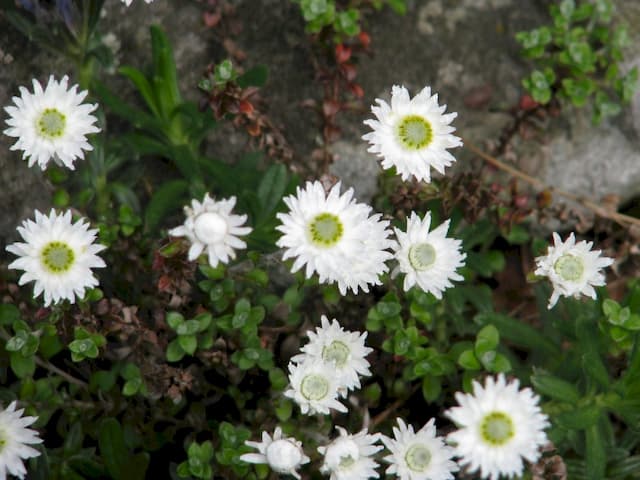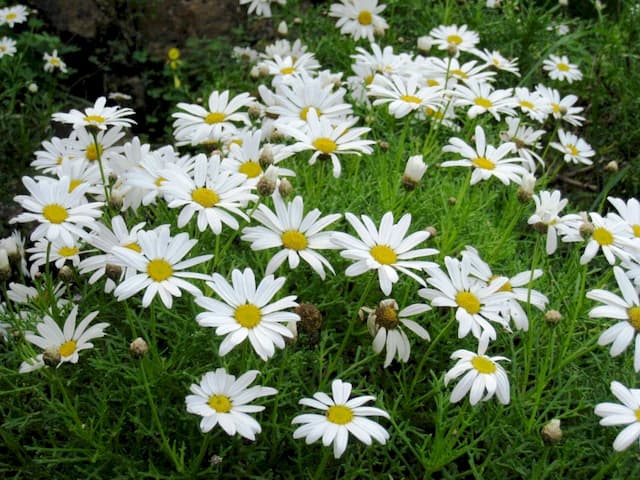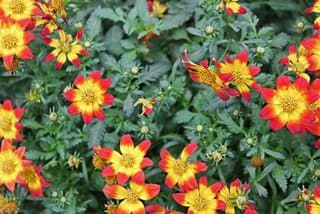African Daisy Osteospermum ecklonis

ABOUT
Commonly known as the African Daisy, this plant is recognizable by its striking flowers that resemble daisies in shape. The blooms come in a variety of colors such as white, pink, purple, and blue, often with a contrasting, darker center known as the eye. The petals radiate around this center, sometimes with a spoon-shaped appearance, and can have unique patterns or two-toned colorations. The foliage of the African Daisy is green and usually consists of narrow leaves that may be slightly serrated or smooth-edged. These leaves form a lush backdrop for the vividly colored flowers, providing a rich tapestry of color and texture. The plant has a bushy habit, creating a dense mound which becomes covered in flowers during the blooming season, presenting a vibrant display ideal for gardens and ornamental containers. The African Daisy's visual appeal is enhanced by its extended flowering period, often blooming from the beginning of spring well into autumn, bringing cheer and color to its surroundings almost year-round.
About this plant
 Names
NamesFamily
Asteraceae.
Synonyms
Cape Daisy, African Daisy, Blue-Eyed Daisy, Osteo.
Common names
Dimorphotheca ecklonis, Osteospermum caulescens, Tripteris ecklonis
 Toxicity
ToxicityTo humans
Cape Daisy is not known to be toxic to humans. Ingesting parts of this plant is unlikely to cause any significant symptoms of poisoning, and it is generally considered safe under normal circumstances when handled or accidentally ingested in small quantities.
To pets
Cape Daisy is also not known to be toxic to pets. It is generally safe for animals, and there are no significant symptoms associated with the ingestion of this plant by pets. However, it is always advisable to monitor pets and prevent them from eating large amounts of any non-food plants as a precautionary measure.
 Characteristics
CharacteristicsLife cycle
Perennials
Foliage type
Evergreen
Color of leaves
Green
Flower color
Varies
Height
1-2 feet (0.30-0.61 meters)
Spread
1-2 feet (0.30-0.61 meters)
Plant type
Herb
Hardiness zones
9-11
Native area
South Africa
Benefits
 General Benefits
General Benefits- Aesthetic Appeal: Cape Daisy adds vibrant colors and unique daisy-like flowers to gardens and landscapes.
- Ease of Care: It is known for being low-maintenance, requiring minimal watering and care to thrive.
- Drought Tolerance: Cape Daisy is relatively drought-tolerant once established, making it suitable for xeriscaping.
- Rapid Growth: It can quickly fill in garden spaces due to its fast growth habit.
- Attracts Pollinators: The flowers are attractive to bees, butterflies, and other beneficial insects, promoting biodiversity.
- Extended Blooming Season: Cape Daisy has a long flowering period from spring into autumn, providing color for several months.
- Versatility: It is suitable for use in containers, borders, and as ground cover, offering flexibility in garden design.
- Soil Adaptability: Cape Daisy can adapt to a range of soil types, although it prefers well-drained soil.
 Medical Properties
Medical PropertiesThis plant is not used for medical purposes.
 Air-purifying Qualities
Air-purifying QualitiesThis plant is not specifically known for air purifying qualities.
 Other Uses
Other Uses- Osteospermum, commonly known as Cape daisies, can be used in sensory gardens as they have a variety of vibrant colors and textures, which stimulate visual and tactile senses.
- These plants can serve as a natural pest deterrent in gardens because some insects avoid the strong scent emitted by their foliage.
- Cape daisies can be used in educational settings, such as schools or botanical gardens, to teach botany and horticulture due to their ease of growth and maintenance.
- Because of their extended blooming period, they are ideal for use in programs that aim to promote planting for continuous floral display to support pollinators throughout the seasons.
- Their drought tolerance makes them suitable for xeriscaping, which is a landscaping method that reduces the need for irrigation.
- Osteospermum can be utilized in floristry as a filler in fresh flower arrangements because they are long-lasting cut flowers.
- As companion plants, Cape daisies can be planted alongside vegetable crops in an eco-friendly garden design to help attract beneficial insects like bees.
- In art projects, their vibrant flower heads can be pressed and used to create botanical prints or for decorating handcrafted cards and bookmarks.
- They are often incorporated into public spaces such as roundabouts, roadside plantings, and urban greening projects due to their easy maintenance and showy flowers.
- Cape daisies can be used in greywater recycling systems for landscapes, as they can tolerate and thrive in the nutrient-rich conditions often found in this type of water.
Interesting Facts
 Feng Shui
Feng ShuiThe Cape Daisy is not used in Feng Shui practice.
 Zodiac Sign Compitability
Zodiac Sign CompitabilityThe Cape Daisy is not used in astrology practice.
 Plant Symbolism
Plant Symbolism- Charm and Beauty: Commonly known as the African Daisy, Osteospermum ecklonis is admired for its daisy-like appearance that symbolizes charm and beauty reminiscent of timeless elegance.
- Perseverance: As a plant that's able to thrive in poor soils and dry conditions, the African Daisy represents perseverance and the ability to overcome challenging circumstances.
- New Beginnings: With its bright, eye-catching blooms that close at night and reopen at dawn, this plant is often associated with new beginnings and the start of a fresh journey.
- Cheerfulness: The vibrant colors and sunny disposition of the African Daisy's flowers signal cheerfulness and positive energy, making them a wonderful symbol of joy.
 Water
WaterAfrican daisies require moderate watering, generally needing about 1 to 1.5 gallons of water per week, depending on the weather conditions. During the growing season, it's best to water them deeply once a week, allowing the soil to dry out slightly between waterings. Overwatering can lead to root rot, so it’s important to ensure that they have well-draining soil. During hot summers, they may need more frequent watering, but always check the top inch of soil for moisture before adding water. Reduce watering in the winter months when the plant's growth slows down.
 Light
LightAfrican daisies thrive in full sun and can tolerate partial shade, but they perform best with at least six hours of direct sunlight per day. Place them in a spot where they will receive plenty of light to encourage abundant flowering. If growing indoors, a south-facing window is ideal to provide the bright light this plant loves.
 Temperature
TemperatureAfrican daisies prefer a temperature range between 50 and 75 degrees Fahrenheit. They can tolerate cooler nights down to around 35 degrees but are sensitive to frost. Optimal growth and flowering occur within this ideal range, while temperatures exceeding 80 degrees can slow down blooming.
 Pruning
PruningPrune African daisies to promote bushier growth and more blooms. Deadheading, or the removal of spent flowers, should be done regularly to encourage continuous flowering. The best time for more extensive pruning is in late winter or early spring, just before new growth begins.
 Cleaning
CleaningAs needed
 Soil
SoilAfrican daisies require well-draining soil mix with a pH between 5.5 and 6.5. A good recipe would be a mix of two parts potting soil, one part perlite, and one part compost to ensure good nutrition and drainage.
 Repotting
RepottingAfrican daisies should be repotted every 1 to 2 years to refresh the soil and allow for growth. The best time to repot is during the early spring, before the onset of the active growing season.
 Humidity & Misting
Humidity & MistingAfrican daisies prefer moderate humidity conditions, around 40-60%. They tend to thrive in outdoor humidity levels and do not require additional indoor humidifying if grown outside their natural environment.
 Suitable locations
Suitable locationsIndoor
Place in bright indirect light and avoid overwatering.
Outdoor
Full sun, well-draining soil, and protect from severe frost.
Hardiness zone
9-11 USDA
 Life cycle
Life cycleOsteospermum ecklonis, commonly known as African Daisy, begins its life cycle as a seed, which upon germinating in favorable conditions, develops into a seedling with its first set of true leaves. As it grows, the seedling matures into a vegetative plant with a robust root system, lush foliage, and begins to form bud clusters. These buds eventually bloom into daisy-like flowers that exhibit a wide array of colors, ranging from white to pink and purple, attracting pollinators which are crucial for the next stage. After pollination, the flowers develop into fruit, which are dry capsules containing seeds. These seeds are then dispersed by wind, water, or animal activity, and once they land in a suitable environment, they will lie dormant until conditions are right for the next generation to germinate, thus continuing the species' life cycle. During unfavorable conditions such as extreme cold or drought, Osteospermum ecklonis may enter a dormant state, conserving its resources until conditions improve.
 Propogation
PropogationPropogation time
Spring to Summer
Osteospermum ecklonis, commonly known as Cape Daisy, is typically propagated through semi-hardwood cuttings. This popular method involves selecting a healthy, semi-mature stem from the parent plant, usually in late summer or early fall. A cutting of about 4 to 6 inches (10 to 15 centimeters) is snipped just below a leaf node, the lower leaves are removed, and the cut end is dipped in rooting hormone. The cutting is then placed in a well-draining potting mix, ensuring that at least one leaf node is below the surface, as this is where roots will develop. The pot should be kept in a warm environment with indirect sunlight and the soil should be kept moist, but not waterlogged, to encourage rooting. Roots typically develop within a few weeks, after which the newly rooted Cape Daisy can be potted up into a larger container or planted out into the garden.









